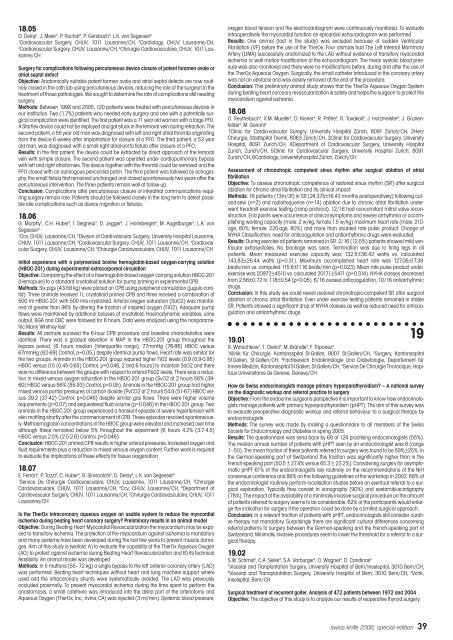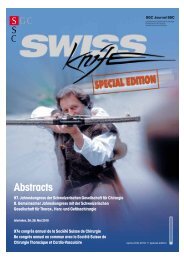Abstracts 4. Gemeinsamer Jahreskongress der ... - SWISS KNIFE
Abstracts 4. Gemeinsamer Jahreskongress der ... - SWISS KNIFE
Abstracts 4. Gemeinsamer Jahreskongress der ... - SWISS KNIFE
Create successful ePaper yourself
Turn your PDF publications into a flip-book with our unique Google optimized e-Paper software.
swissknife spezial 06 12.06.2006 13:39 Uhr Seite 39<br />
18.05<br />
D. Delay 1 , J. Meier 2 , P. Ruchat 3 , P. Gersbach 3 , L.K. von Segesser 4<br />
1 Cardiovascular Surgery, CHUV, 1011 Lausanne/CH, 2 Cardiology, CHUV, Lausanne/CH,<br />
3 Cardiovascular Surgery, CHUV, Lausanne/CH, 4 Chirurgie Cardiovasculaire, CHUV, 1011 Lausanne/CH<br />
Surgery for complications following percutaneous device closure of patent foramen ovale or<br />
atrial septal defect<br />
Objective: Anatomically suitable patent formen ovale and atrial septal defects are now routinely<br />
closed in the cath lab using percutaneous devices, reducing the role of the surgeon in the<br />
treatment of those pathologies. We sought to determine the rate of complications still needing<br />
surgery.<br />
Methods: Between 1998 and 2005, 120 patients were treated with percutaneous devices in<br />
our institution. Two (1.7%) patients who needed early surgery and one with a potentially surgical<br />
complication were identified. The first patient was a 71 year old woman with a large PFO.<br />
A Starflex device could not be deployed and got stuck in the femoral vein during retraction. The<br />
second patient, a 56 year old man was diagnosed with left and right atrial thrombi originating<br />
from the device 6 weeks after implantation for closure of a PFO. The third patient, a 53 year<br />
old man, was diagnosed with a small right atrial-aorta fistula after closure of a PFO.<br />
Results: In the first patient, the device could be extracted by direct approach of the femoral<br />
vein with simple closure. The second patient was operated un<strong>der</strong> cardiopulmonary bypass<br />
with left and right atriotomies. The device together with the thrombi could be removed and the<br />
PFO closed with an autologous pericardial patch. The third patient was followed by echography,<br />
the small fistula first remained unchanged and closed spontaneously two years after the<br />
percutaneous intervention. The three patients remain well at follow-up.<br />
Conclusion: Complications after percutaneous closure of interatrial communications requiring<br />
surgery remain rare. Patients should be followed closely in the long term to detect possible<br />
late complications such as device migration or fistulas.<br />
18.06<br />
G. Murphy 1 , C.H. Huber 2 , I. Seigneul 1 , D. Jegger 3 , J. Horisberger 4 , M. Augstburger 1 , L.K. von<br />
Segesser 5<br />
1 Ccv, CHUV, Lausanne/CH, 2 Divison of Cardi-vascular Surgery, University Hospital Lausanne,<br />
CHUV, 1011 Lausanne/CH, 3 Cardiovascular Surgery, CHUV, 1011 Lausanne/CH, 4 Cardiovascular<br />
Surgery, CHUV, Lausanne/CH, 5 Chirurgie Cardiovasculaire, CHUV, 1011 Lausanne/CH<br />
Initial experience with a polymerized bovine hemoglobin-based oxygen-carrying solution<br />
(HBOC-201) during experimental extracorporeal circulation<br />
Objective: Comparing the effect of a haemoglobin-based oxygen carrying solution HBOC-201<br />
(Hemopure) to a standard crystalloid solution for pump priming in experimental CPB.<br />
Methods: Six pigs (43-58 kg) were placed on CPB using peripheral cannulation (jugulo-carotid).<br />
Three animals received 1L crystalloid primed CPB and three received a combination of<br />
500 ml HBOC-201 with 500 mls crystalloid. Arterial oxygen saturation (SaO2) was maintained<br />
at greater than 96% by altering the fraction of inspired oxygen (FiO2). Adequate pump<br />
flows were maintained by additional boluses of crystalloid. Haemodynamic variables, urine<br />
output, BGA and CBC were followed for 6 hours. Data were analyzed using the nonparametric<br />
Mann Whitney test.<br />
Results: All animals survived the 6-hour CPB procedure and baseline characteristics were<br />
identical. There was a gradual elevation in MAP in the HBOC-201 group throughout the<br />
bypass period, (6 hours median (Interquartile range), 77mmHg (76-86) HBOC versus<br />
67mmHg (62-69) Control, p=0.05,) despite identical pump flows. Heart rate was similar for<br />
the two groups. Animals in the HBOC-201 group required higher FiO2 levels (0.9 (0.9-0.95)<br />
HBOC versus 0.5 (0.45-0.65) Control, p=0.046, 2 and 6 hours) to maintain SaO2 and there<br />
was no difference between the groups with respect to arterial Pa02 levels. There was a reduction<br />
in mixed venous oxygen saturation in the HBOC-201 group (SvO2 at 2 hours 56% (39-<br />
60) HBOC versus 86% (85-93) Control, p=0.05). Animals in the HBOC-201 group had higher<br />
mixed venous partial pressures of carbon dioxide (PvCO2 at 2 hours 5<strong>4.</strong>8 (51-67) HBOC versus<br />
39.2 (37-42) Control, p=0.046) despite similar gas flows. There were higher volume<br />
requirements (p=0.07) and sequestered fluid volume (p=0.046) in the HBOC-201 group. Two<br />
animals in the HBOC-201 group experienced a transient episode of severe hypertension with<br />
skin mottling shortly after the commencement of CPB. These episodes resolved spontaneously.<br />
Methaemoglobin concentrations in the HBOC group were elevated and increased over time<br />
although these remained below 5% throughout the experiment (6 hours <strong>4.</strong>2% (3.7-<strong>4.</strong>5)<br />
HBOC versus 2.5% (2.5-2.6) Control, p=0.046).<br />
Conclusion: HBOC-201 primed CPB results in higher arterial pressures, increased oxygen and<br />
fluid requirements plus a reduction in mixed venous oxygen content. Further work is required<br />
to evaluate the implications of these effects for tissue oxygenation<br />
18.07<br />
E. Ferrari 1 , P. Tozzi 2 , C. Huber 3 , G. Siniscalchi 2 , D. Delay 4 , L.K. von Segesser 5<br />
1 Service De Chirurgie Cardiovasculaire, CHUV, Lausanne, 1011 Lausanne/CH, 2 Chirurgie<br />
Cardiovasculaire, CHUV, 1011 Lausanne/CH, 3 Ccv, CHUV, Lausanne/CH, 4 Department of<br />
Cardiovascular Surgery, CHUV, 1011 Lausanne/CH, 5 Chirurgie Cardiovasculaire, CHUV, 1011<br />
Lausanne/CH<br />
Is the TherOx intracoronary aqueous oxygen an usable system to reduce the myocardial<br />
ischemia during beating heart coronary surgery? Preliminary results in an animal model<br />
Objective: During Beating Heart Myocardial Revascularization the myocardium may be exposed<br />
to transitory ischemia. The protection of the myocardium against ischemia is mandatory<br />
and many systems have been developed during the last few years to prevent muscle damages.<br />
Aim of this study is twofold: A) to evaluate the capability of the TherOx Aqueous Oxygen<br />
(AO) to protect against ischemia during Beating Heart Revascularization and B) its technical<br />
feasibility. An animal model was developed<br />
Methods: In 5 muttons (55–72 kg) a single bypass to the left anterior coronary artery (LAD)<br />
was performed. Beating heart techniques without heart and lung machine support where<br />
used and the intracoronary shunts were systematically avoided. The LAD was previously<br />
occluded proximally. To prevent myocardial ischemia during the time spent to perform the<br />
anastomosis, a small catethere was introduced into the distal part of the arteriotomy and<br />
Aqueous Oxygen (TherOx, Inc.; Irvine, CA) was injected (3 ml/min). Systemic blood pressure,<br />
oxygen blood tension and the electrocardiogram were continuously monitored. To evaluate<br />
intraoperatively the myocardial function an epicardial echocardiogram was performed<br />
Results: One animal (last in the study) was excluded because of sudden Ventricular<br />
Fibrillation (VF) before the use of the TherOx. Four animals had The Left Internal Mammary<br />
Artery (LIMA) successfully anatomized to the LAD without evidence of transitory myocardial<br />
ischemia or wall motion modification at the echocardiogram. The mean systolic blood pressure<br />
was also monitored and there were no modifications before, during and after the use of<br />
the TherOx Aqueous Oxygen. Surgically, the small catheter introduced in the coronary artery<br />
was not an obstacle and was easely removed at the end of the procedure.<br />
Conclusion: This preliminary animal study shows that the TherOx Aqueous Oxygen System<br />
during beating heart coronary revascularization is safety and helps the surgeon to protect the<br />
myocardium against ischemia.<br />
18.08<br />
O. Reuthebuch 1 , X.M. Mueller 2 , D. Kisner 3 , R. Prêtre 4 , R. Tavakoli 5 , J. Holzmeister 6 , J. Grunenfel<strong>der</strong><br />
5 , M. Genoni 2<br />
1Clinic for Cardio-vascular Suregry, University Hospital Zürich, 8091 Zürich/CH, 2Herz<br />
Chirurgie, Stadtspital Triemli, 8063 Zürich/CH, 3Clinic for Cardiovascular Surgery, University<br />
Hospital, 8091 Zurich/CH, 4Department of Cardiovascular Surgery, University Hospital<br />
Zurich, Zurich/CH, 5Clinic for Cardiovascular Surgery, University Hospital Zurich, 8091<br />
Zurich/CH, 6Cardiology, Universityhospital Zürich, Zürich/CH<br />
Assessment of chronotropic competent sinus rhythm after surgical ablation of atrial<br />
fibrillation<br />
Objective: To assess chronotropic competence of restored sinus rhythm (SR) after surgical<br />
ablation for chronic atrial fibrillation and its clinical impact.<br />
Methods: 16 patients (13m/3f) in SR (2<strong>4.</strong>375±16.43 months postoperatively) following cutand-sew<br />
(n=2) and radiofrequence (n=14) ablation due to chronic atrial fibrillation un<strong>der</strong>went<br />
treadmill exercise testing (ramp protocol). 12/16 had concomitant mitral valve reconstruction.<br />
End points were occurrence of clinical symptoms and severe arrhythmia or accomplishing<br />
working capacity (male: 2 w/kg, female:1.5 w/kg) maximum heart rate (male: 210age,<br />
80%; female: 220-age, 80%) and more than doubled rate pulse product. Change of<br />
NYHA Classification, need for anticoagulation and antiarrhythmic drugs were evaluated.<br />
Results: During exercise all patients remained in SR. 2/16 (12.5%) patients showed mild ventricular<br />
extrasystolies. No blockage was seen. Termination was due to tiring legs in all<br />
patients. Mean measured exercise capacity was 132.5±36.42 watts vs. calculated<br />
143.83±26.44 watts (p=0.31). Maximum accomplished heart rate was 127.06±17.39<br />
beats/min vs. computed 115.6±11.16 beats/min (p=0.023). Mean rate pulse product un<strong>der</strong><br />
exercise was 20972±4510 vs. calculated 20171±5411 (p=0.314). NYHA classes decreased<br />
from 2.56±0.72 to 1.18±0.54 (p
















